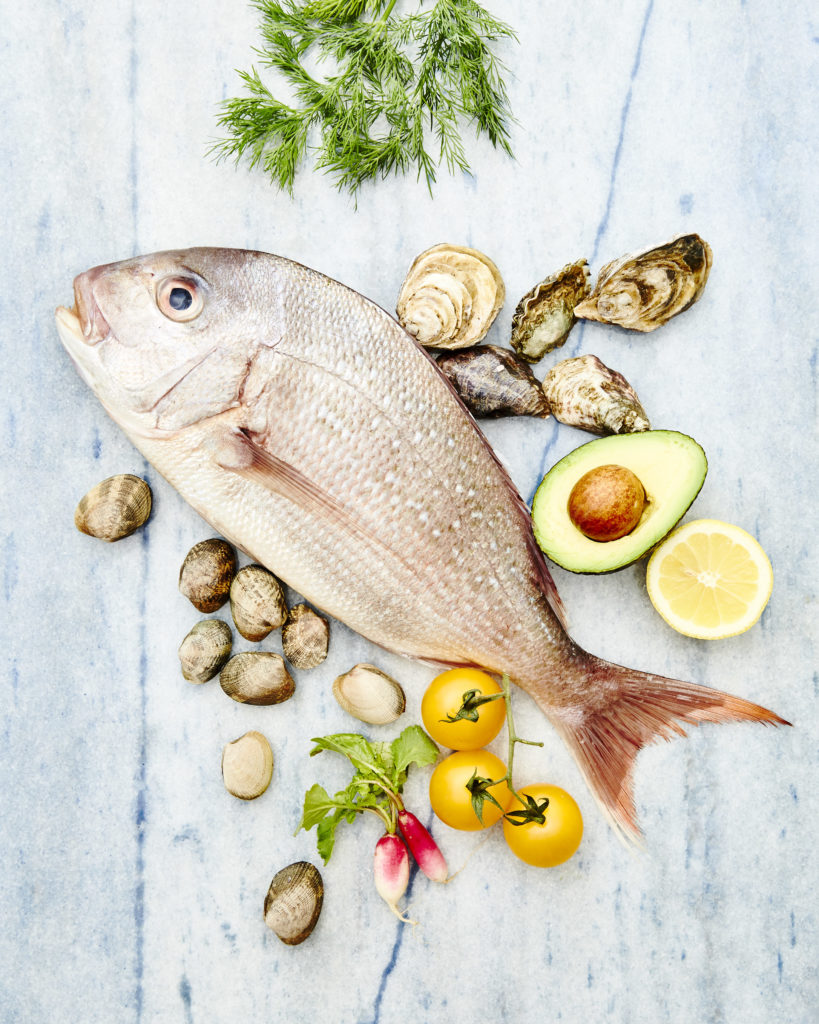In the book Pescan: A Feel Good Cookbook Abbie Cornish and I share our favorite healthy and delicious recipes. We also go over basic cooking techniques and batch cooking at home. At the foundation of the book is the way we prefer to cook and eat, choosing foods that are not only tasty, but that also make us feel good. It’s a lifestyle that we both feel changed our lives for the better. We call this lifestyle “Pescan”
Personally, eating pescan has given me a newfound sense of freedom around food. I can eat whenever I’m hungry, stop when I’m full, and always feel satisfied and nourished. Gone are the days of counting calories or yo-yo diets. I maintain a healthy weight without ever having to think about it, which is a welcome relief to someone who spent years dieting. I’m able to feed myself and my family in a way that is super nutritious but still feels like a joy rather than a burden. But what is pescan exactly? Read on to find out more…
Below is an excerpt from Pescan: A Feel Good Cookbook available from Abrams Books
pes·can
/peskən/
1. not containing red meat, poultry, or dairy; consisting wholly of vegetables, fruits, fungi, grains, legumes, nuts, and sometimes eggs or seafood.
2. a person who follows a pescan lifestyle.
Pescan Basics
Eat fruits and/or vegetables at every meal (a.k.a. #eattherainbow).
These days there are about a million different theories on the best way to eat, but the one thing everyone agrees on is that we should be eating more plants. Having a plant-focused diet means you’re absorbing a ton of vitamins, minerals, fiber, and healthy fats without even trying. Making vegetables the center of our diet has had the biggest effect on how we feel. It makes your whole body run more efficiently. Good digestion, improved mood, and higher energy levels are all perks. Plus, your immune system will get a huge boost.
As if those health benefits aren’t enough, scientists have proven a little secret that we’ve known for a while—eating lots fruits and veggies actually makes you look better. They help you maintain a healthy weight thanks to all of the fiber they contain, which gives you that full, satisfied feeling. You’ll also notice that a lot of cravings will disappear once your body is getting all of the nutrients it needs. Studies have even shown that what people perceive as a “healthy glow” comes from eating the pigments that give fruits and vegetables their color.
If eating a lot of produce is new to you, don’t feel like you have to radically shift your diet immediately to get the benefits. Start by adding veggies to the foods you’re already making. Add some onions and spinach to your breakfast scramble, throw some zucchini and carrots into your pasta sauce, add avocado and tomato to your sandwich, and freshen up your granola with sweet berries. You can make vegetables and fruit a bigger part of each meal as you get used to cooking and eating more of them.
Eat food that is as close to its natural state as possible.
Stick to organic produce, grains, legumes, nuts, sustainable seafood, and free-range eggs whenever possible. This will guarantee that everything you are eating is nutrient-dense and nourishing. It will also help you avoid toxic pesticides and genetically modified foods. Remember whole foods—the way nature intended—are always best, so leave the peel on fruits and veggies, eat whole grains, and keep the yolks in your eggs.
Avoid processed foods with added chemicals, refined sweeteners, or added flavors. Even those “natural flavors” in the ingredients list can include artificial ingredients such as synthetic solvents or preservatives. It’s best to stay away from foods with labels like low-calorie, low-fat, or gluten-free unless those foods are naturally that way. Ditch the refined sugars like white or brown sugar and switch to whole-food sweeteners such as honey, maple syrup, and dates.
Eat fish two to three times per week.
The American Heart Association recommends eating fish at least two times a week and so do we. Fish provides nutrients such as vitamin B12 and DHA and EPA omega-3s that are impossible to get enough of on a completely plant-based diet without eating fortified foods or taking supplements. This is one of the reasons we prefer the pescan diet rather than a strictly vegan diet. These omega-3 fats are essential for proper brain function and heart health, and vitamin B12 helps with a wide array of our body’s functions, like keeping our hormones in balance and maintaining healthy nervous and cardiovascular systems.
Aside from being full of nutrients that so beautifully complement a plant-based diet, seafood is quite simply delicious. It makes a wonderful centerpiece for a special- occasion meal, is quick enough to prepare on any weeknight, and can be an easy, nutritious option when eating out. At many restaurants, the only dairy-free vegetarian options might be steamed vegetables and a baked potato. Add some grilled fish, and you have a balanced and satisfying meal.
Eat seasonally.
While you may not be familiar with the term “pescan,” it is not really a new way of eating. This is the staple diet of many native coastal communities that have some of the highest longevity rates. Its foundation is in macrobiotics and the Mediterranean diet. As with each of those diets, we recommend focusing on local and seasonal ingredients in your cooking. Doing so ensures that you’re eating the freshest, most nutritious food possible. It’s also generally the most cost-effective and environmentally friendly way to eat. Produce begins to lose nutritional value soon after it has been picked, so the faster it goes from the farm to your table, the better.
Avoid red meat and dairy.
There are a number of studies linking red meat consumption to increased risk for cancer and heart disease, with processed meats like hot dogs and deli meats being the worst for your body. Exposure to antibiotics and hormones in meat and the negative environmental effects of industrial animal farming are also of concern.
As for dairy, giving it up may feel like a bit of a sacrifice initially, but it’s so worthwhile! We know that might sound crazy, but if we told you that you could have better skin, less bloating, and never have to count calories again, wouldn’t that be worth taking into consideration? Dairy is one of the most common allergens and can make problems like acne, asthma, and irritable bowel syndrome worse. For a lot of people, it creates inflammatory responses like heartburn, lack of energy, and joint pain. In fact, more than 60 percent of the world’s population is believed to have a dairy intolerance.
Cutting out meat and dairy may take some getting used to, but it’s really not as hard as you think. Most people who switch to a pescan diet feel and look so much better that the transition is much easier than expected. If you are not ready to give up these animal foods completely, try to incrementally lower your consumption. Buy only pasture-raised or grass-fed meats and dairy, which are more nutritious than factory-farmed products, and think of them as an accent to your meal rather than the star. Switch to veggie burgers and dogs. Try to have at least one completely plant-based meal per day. This isn’t about an overnight quick fix; it’s about changing your lifestyle for the better in a sustainable way that works for you.
Eggs and gluten are optional, so figure out if they work for you.
We put these foods in the optional category because a big chunk of the population has intolerances or allergies to them. They may be particularly problematic for those with autoimmune or thyroid issues, but others may be fine with them and think scrambled eggs on whole-wheat toast makes the most fabulous breakfast ever. For that reason, you really have to figure out what works for you. If you think you may be intolerant, the best way to find out is either to get tested for food allergies or go the less expensive route and do an elimination diet. This is especially important if you have digestive issues, skin problems, or lack of energy even after getting enough sleep. To try an elimination diet, cut the food in question out for 3-4 weeks and see if your symptoms improve, then reintroduce it into your diet. Really check in with your body to see if there are any negative reactions like fatigue, joint pain, headaches, indigestion, nausea, rashes, bloating etc. If you feel ok, then feel free to eat them in moderation. If you feel better without them, then do your best to avoid them altogether.
We both love a slice of fresh-baked whole-grain or sourdough bread on occasion but tend to avoid gluten most of the time, so we have made sure to include gluten-free options for each of the recipes. As for eggs, we both enjoy organic, pasture-raised eggs occasionally. Whole eggs can be a good source of protein, vitamin D, B12, and other important nutrients, so we included a chapter with egg recipes. We left them out of our other recipes, however, including baked goods and veggie burgers. So, if you’re avoiding them, don’t worry. Most of the recipes will still work for you.
Remember the pescan diet is not a diet!
It’s one of the great limitations of the English language that there is only one word to describe both a temporary weight-loss plan and the kinds of food that a person regularly eats. Pescan is the latter, which is why we prefer to call it a lifestyle. This is not a temporary fix or about dropping a few pounds to fit into a dress. It’s the process of regularly choosing foods that make you feel amazing until it becomes a way of life. You may lose weight initially, but once you get to a healthy weight, you’ll stay there. You can literally throw away your scales. We did, and it felt great.
by Abbie Cornish and Jacqueline King Schiller from Pescan: A Feel Good Cookbook available from Abrams Books
Lifestyle Photography by Camraface Food Photography by Ren Fuller



